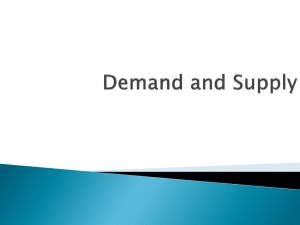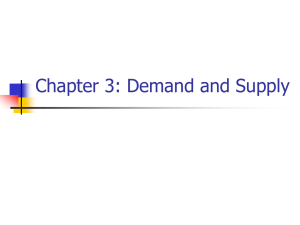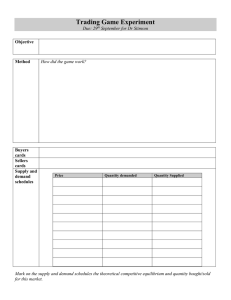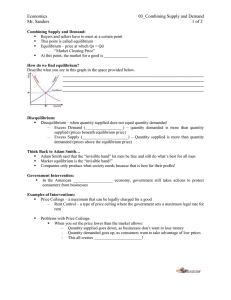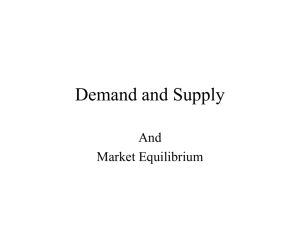Chapter 2: Demand, Supply, and Market Equilibrium Lecture2
advertisement
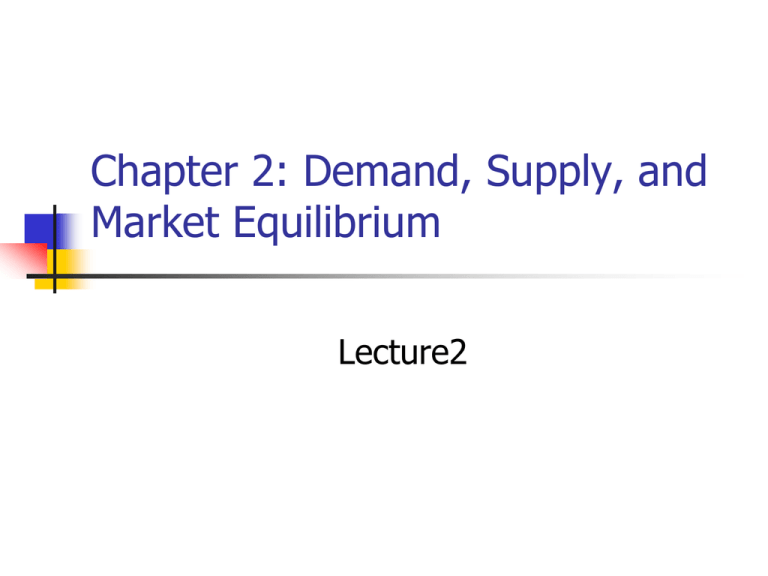
Chapter 2: Demand, Supply, and Market Equilibrium Lecture2 Markets A market is a meeting place where buyers and sellers are able to trade with each other. At market economy, the price of a good is determined by the interaction of demand and supply I. Demand A relationship between price and quantity demanded in a given time period, ceteris paribus. Law of demand An inverse relationship exists between the price of a good and the quantity demanded in a given time period, (ceteris paribus assumption). The Demand curve The Demand Curve shows how much the buyers are willing to buy at different prices of goods. Person Demand demand P 6 5 4 3 2 1 0 0 20 40 60 80 Q 100 Quantity demanded Price/kilogram 10 5 ryal 20 4 35 3 55 2 80 1 Market Demand Price (ryal) 5 Buyer one 4 20 23 43 3 35 39 74 2 55 60 115 1 80 87 167 10 Buyer 2 + 12 Market Demand = 22 5 5 4 4 3 3 2 2 1 1 0 0 0 20 35 40 60 80 0 10 20 30 3940 50 60 Market Demand 5 5 4 4 3 3 2 2 1 1 0 0 20 40 60 70 80 Q Q P P Person 2 demand P Person 1 demand 80 74 100 120 140 Q 160 90 Market demand curve Market demand is the horizontal summation of individual consumer demand curves. Determinants of demand tastes and preferences prices of related goods and services Complementary goods: goods that are typically consumed together. Substitute goods: goods that can be used instead of each other income number of consumers expectations of future prices and income Tastes and preferences Effect of fads: Price of related goods substitute goods – an increase in the price of one results in an increase in the demand for the other. complementary goods – an increase in the price of one results in a decrease in the demand for the other. Change in the price of a substitute good Price of coffee rises: Change in the price of a complementary good Price of DVDs rises: Income and demand: normal goods A good is a normal good if an increase in income results in an increase in the demand for the good. Income and demand: inferior goods A good is an inferior good if an increase in income results in a reduction in the demand for the good. Demand and the number of buyers An increase in the number of buyers results in an increase in demand. Expectations A higher expected future price will increase current demand. A lower expected future price will decrease current demand. II. Supply The relationship that exists between the price of a good and the quantity supplied in a given time period, ceteris paribus. Law of supply A direct relationship exists between the price of a good and the quantity supplied in a given period of time, (ceteris paribus assumption). Reason for law of supply The price is a Revenue for the producers. High prices are necessary to encourage offers and production high prices are necessary to cover production costs. Person Supply 6 5 P 4 3 2 1 0 0 10 20 30 40 50 60 Q Quantity supplied Price 60 5 50 4 35 3 20 2 5 1 Change in supply vs. change in quantity supplied Change in supply Change in quantity supplied Individual firm and market supply curves The market supply curve is the horizontal summation of the supply curves of individual firms. (This is equivalent to the relationship between individual and market demand curves.) Determinants of supply the price of resources, technology and productivity, the expectations of producers, the number of producers, and the prices of related goods and services Price of resources As the price of a resource rises, profitability declines, leading to a reduction in the quantity supplied at any price. Technological improvements Technological improvements (and any changes that raise the productivity of labor) lower production costs and increase profitability. Expectations and supply An increase in the expected future price of a good or service results in a reduction in current supply. Increase in number of sellers Prices of other goods Firms produce and sell more than one commodity. Firms respond to the relative profitability of the different items that they sell. The supply decision for a particular good is affected not only by the good’s own price but also by the prices of other goods and services the firm may produce. III. Market equilibrium A market is in equilibrium ? the intersection between the supply and demand curves in one diagram get an equilibrium point . Equilibrium price and equilibrium quantity P* Q* Equilibrium Price The equilibrium price of a good is: a price at which quantity supplied equals quantity demanded. a price at which excess demand equals zero. At the equilibrium price there is no net tendency for price to change. Equilibrium quantity The equilibrium quantity of a good is: a quantity that is bought and sold when there is an equilibrium in the market. How to find the equilibrium mathematically Example: Supply and Demand can be written as mathematical functions: Qs =85 + 30p Qd = 185 -20p Example (continued) We now want to find the price, p* that makes Qs = Qd 85+30p* = 185 – 20p* 30p* + 20p* = 185 -85 50p* = 100 P* =2 Example (continued) Q* =? Q* = 85 +30*p* Q* = 85 +30*2 =145 OR Q* = 185 – 20*2 Q* = 145 Excess demand and supply Excess demand exists when, at the Excess supply exists when, at the current price, the quantity demanded is greater than quantity supplied. current price, the quantity supplied is greater than the quantity demanded. Excess supply = Qs - QD price EXCESS SUPPLY supply P demand QD QS Q Excess demand = QD - QS price supply EXCESS DEMAND P demand QS QD Q Demand rises price increases from p1 to p2 and quantity demanded rises from q1 to q2 p2 p1 q1 q2 Demand rises When there is EXCESS DEMAND for a good, price will tend to rise. Consumers rises price to p2, QS increases and QD decreases, The new equilibrium is attained at p2,q2. Demand falls price decreases from p1 to p2 and quantity demanded decreases from q1 to q2 p1 p2 q2 q1 Demand falls Producers decides to decrease the price in p2, QD rises and Qs falls And the new equilibrium is attained at p2,q2. Supply rises price decreases from p1 to p2 and quantity supplied increases from q1 to q2 Supply rises When there is EXCESS SUPPLY of a good, price will tend to fall. Producers falls the price to p2, QD increases and QS decreases, And the new equilibrium is attained at p2,q2 Supply falls price increases from p1 to p2 and quantity supplied decreases from q1 to q2 Supply falls Consumers rises price to p2, QS increases and QD decreases, And the new equilibrium is attained at p2,q2

